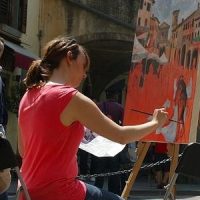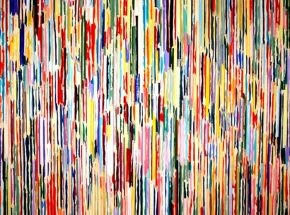

I have often discussed my work as a love for humanity, for the human form, and individuality. I have paralleled my pieces to a type of cultural document, an evidentiary tool describing the subject matter that is within my personal contemporary world. This statement is true; I love people, am interested in physical attributes of the human form and do depict people related to my life. But there unmistakably is an attraction to the expression of the human form that I share with so many other artists. I am fascinated with this draw or pull I experience that instantly links me personally with my subject. The curiosity I have in getting to know that person and depict them grows increasingly great. There is undeniably a sense of embodiment and empathy I feel when creating portraits and figurative work.
We, as human beings, possess the uncanny ability to feel through another person. “Putting oneself in another’s shoes” is not just an old saying, it is a real phenomenon. We are able to share in someone else’s joy, pain, or anger without their external stimulus. We can cry for the loss of a loved one, or a friend’s loss of a loved one. We can even feel the emotions of the actors on a stage or on a screen, without knowing them personally. This psychological ability absolutely astounds me. I paint people with this sense of familiarity that projects itself onto the viewers. My goal is to connect the viewer with the subjects, to experience the emotions they express.
Furthermore, this feeling for another, though very much linked to our minds, cannot be separated from the physicality of our bodies. As human beings, we experience everything we know from within our bodies, our framework. That provides us with our pool of knowledge and experiences. Our bodies are our vessel of communication–speech, body language, posture, gaze–every outlet for transferring feelings to another is used. This idea of the impossibility of separation of mind and body is seen in all disciplines of science and math. Andy Clark, professor at Washington University, writes of this idea in the study of cognitive science. He writes, “Cognitive Science is in some sense the science of the mind. But an increasingly influential theme, in recent years, has been the role of the physical body, and of the local environment, in promoting adaptive success.” 1 Clark, Andy Washington University Press Embodiment and the philosophy of the mind”. In his study, the psychological aspects are shown to be strongly linked to our experiential data from our bodies. This idea clearly transfers into the realm of art. Robert Hughes’s “On Lucien Freud” clearly refers to this relationship between mind and body. He writes, “We are never loose from our bodies and the re-embodiment of our experience of that world–its delivery from the merely conceptual, the unfelt, the second-hand or the rhetorically transcendent–is what painting offers.” 8. He admits that a key success in Freud’s work is the undeniable honesty of the connection to the human form and the “re-embodiment of our experience”.
Robert Hughes makes another quite interesting remark, “In “normal” portraiture, a tacit agreement between painter and subject allows the sitter to mask himself and project this mask–of success, of dignity, of beauty, of role–upon the world.” I read this statement with great emphasis on the word “mask”. I constantly involve myself in the theatre arena. Having performed, and seen many others perform, I am attracted in this idea of the “mask”. I am greatly interested in not only portraying people in their natural environment and emphasizing their own character, but also the masks that often can be exaggerations of these expressions. or completely in contrast to the actual persona of the individual. My work investigates these different expressions and plays upon the instinctual human ability to connect with other humans.
Website
http://www.jillianbonahoom.com
